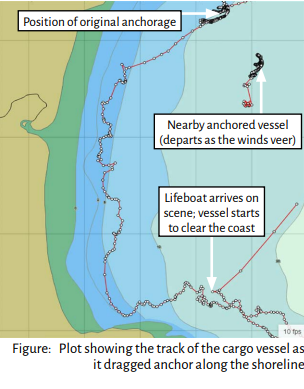As UK MAIB reports in its most recent Safety Digest, a general cargo vessel was preparing to depart port to allow another vessel to berth.
The incident
The cargo vessel’s master, having noted violent storms were forecast, sought advice about two local anchorages: one was nearby and free to use, the other offered better protection but was further away and incurred a cost. The nearby anchorage was selected and the cargo vessel proceeded to sea and dropped anchor close inshore. By the time the storm hit later that evening, three other vessels had also anchored close to the cargo vessel.
As the storm winds veered to the north-east the cargo vessel lost all shelter; it started to drag anchor and, 25 minutes later, was dangerously close to land on a lee shore. The master and crew fought hard for 2 hours to recover their anchor and proceed out to sea, during which the ship dragged southwards along the coast and was within a few metres of grounding on several occasions.
The master managed to manoeuvre the cargo vessel into deeper water as the wind decreased slightly. With lifeboats in attendance, and at a safe distance from land, the crew eventually managed to recover the anchor and make passage to their next port. After an exceptionally tiring and perilous few hours, it was extremely fortunate that the vessel emerged unscathed and avoided being wrecked on the coast.

Lessons learned
- Check → Consider the weather forecast when selecting a safe anchorage. A change of wind direction can make a dramatic difference. The anchorage in this case initially afforded excellent protection from the storm winds, but left the vessel exposed as the winds veered around to the north-east as forecast. A lee shore is a dangerous place for a vessel to find itself caught.
- Plan → Determine what alternative courses of action are available if it is not possible to remain at anchor during heavy weather. Potential solutions include veering more cable, deploying a second anchor or releasing the anchor entirely and proceeding to sea.
- Action → It is sometimes better to stay at sea and heave to in the worst of the weather. The master and crew made an early call for help, worked the engines hard to prevent the ship grounding and were able to continue safely on passage when the weather subsided, but it had been a very close call.






























































